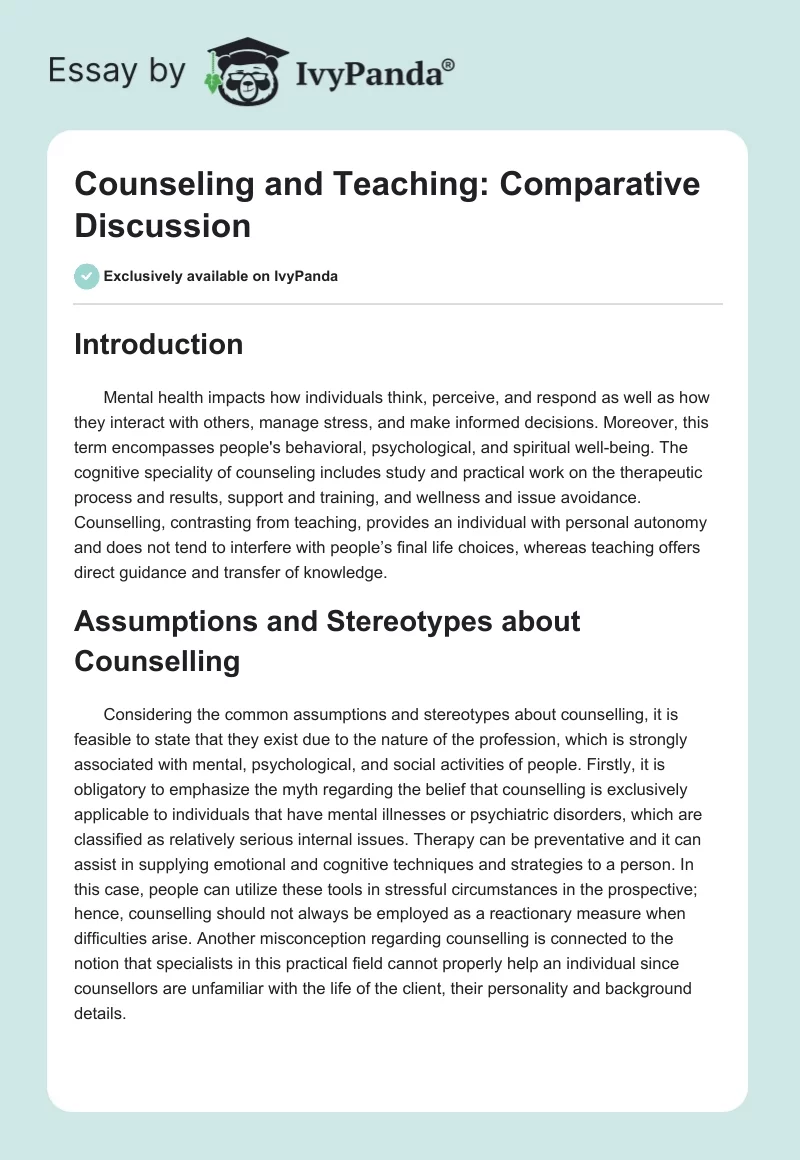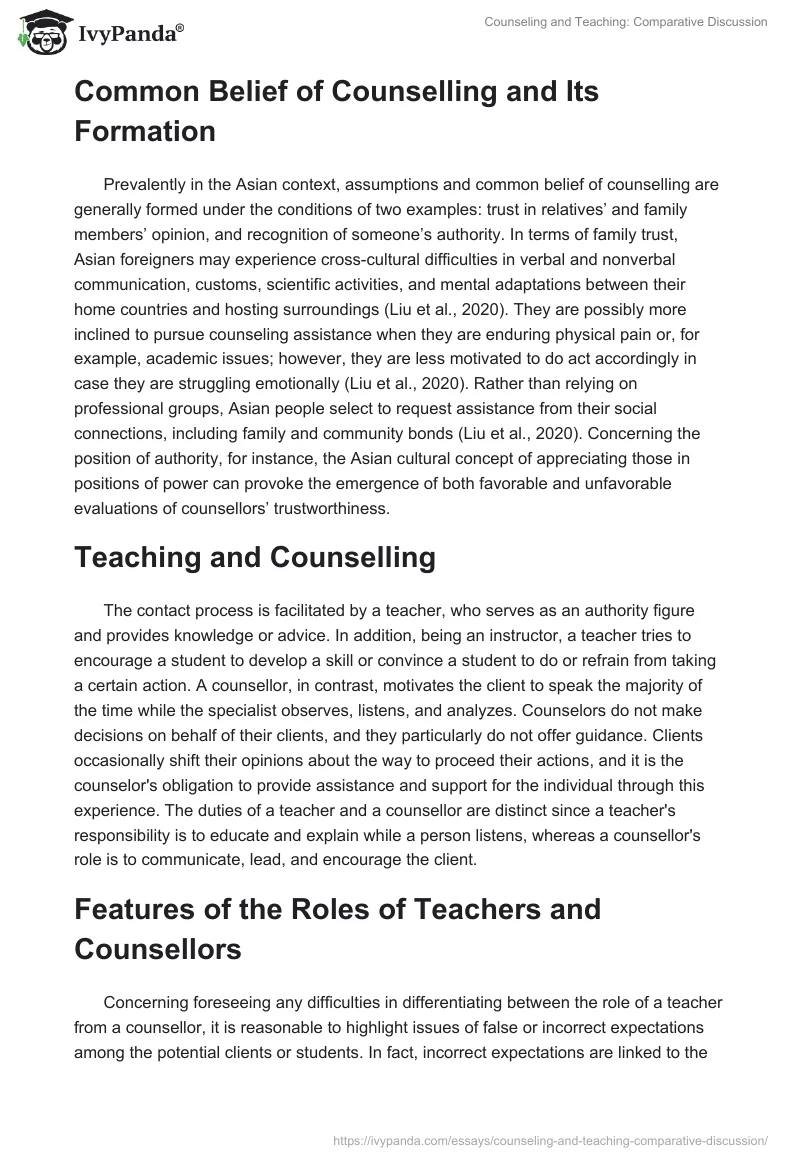- Introduction
- Assumptions and Stereotypes about Counselling
- Common Belief of Counselling and Its Formation
- Teaching and Counselling
- Features of the Roles of Teachers and Counsellors
- Ethical Issues in Counselling
- Problems of Children and Adolescents
- Risk of Mental Health Issues among Children
- Conclusion
- References
Introduction
Mental health impacts how individuals think, perceive, and respond as well as how they interact with others, manage stress, and make informed decisions. Moreover, this term encompasses people’s behavioral, psychological, and spiritual well-being. The cognitive speciality of counseling includes study and practical work on the therapeutic process and results, support and training, and wellness and issue avoidance. Counselling, contrasting from teaching, provides an individual with personal autonomy and does not tend to interfere with people’s final life choices, whereas teaching offers direct guidance and transfer of knowledge.
Assumptions and Stereotypes about Counselling
Considering the common assumptions and stereotypes about counselling, it is feasible to state that they exist due to the nature of the profession, which is strongly associated with mental, psychological, and social activities of people. Firstly, it is obligatory to emphasize the myth regarding the belief that counselling is exclusively applicable to individuals that have mental illnesses or psychiatric disorders, which are classified as relatively serious internal issues. Therapy can be preventative and it can assist in supplying emotional and cognitive techniques and strategies to a person. In this case, people can utilize these tools in stressful circumstances in the prospective; hence, counselling should not always be employed as a reactionary measure when difficulties arise. Another misconception regarding counselling is connected to the notion that specialists in this practical field cannot properly help an individual since counsellors are unfamiliar with the life of the client, their personality and background details.
Common Belief of Counselling and Its Formation
Prevalently in the Asian context, assumptions and common belief of counselling are generally formed under the conditions of two examples: trust in relatives’ and family members’ opinion, and recognition of someone’s authority. In terms of family trust, Asian foreigners may experience cross-cultural difficulties in verbal and nonverbal communication, customs, scientific activities, and mental adaptations between their home countries and hosting surroundings (Liu et al., 2020). They are possibly more inclined to pursue counseling assistance when they are enduring physical pain or, for example, academic issues; however, they are less motivated to do act accordingly in case they are struggling emotionally (Liu et al., 2020). Rather than relying on professional groups, Asian people select to request assistance from their social connections, including family and community bonds (Liu et al., 2020). Concerning the position of authority, for instance, the Asian cultural concept of appreciating those in positions of power can provoke the emergence of both favorable and unfavorable evaluations of counsellors’ trustworthiness.
Teaching and Counselling
The contact process is facilitated by a teacher, who serves as an authority figure and provides knowledge or advice. In addition, being an instructor, a teacher tries to encourage a student to develop a skill or convince a student to do or refrain from taking a certain action. A counsellor, in contrast, motivates the client to speak the majority of the time while the specialist observes, listens, and analyzes. Counselors do not make decisions on behalf of their clients, and they particularly do not offer guidance. Clients occasionally shift their opinions about the way to proceed their actions, and it is the counselor’s obligation to provide assistance and support for the individual through this experience. The duties of a teacher and a counsellor are distinct since a teacher’s responsibility is to educate and explain while a person listens, whereas a counsellor’s role is to communicate, lead, and encourage the client.
Features of the Roles of Teachers and Counsellors
Concerning foreseeing any difficulties in differentiating between the role of a teacher from a counsellor, it is reasonable to highlight issues of false or incorrect expectations among the potential clients or students. In fact, incorrect expectations are linked to the process of personal interpretation that can be biased among various individuals. Consequently, a biased and misinterpreted perception of what are the fundamental duties of teachers and counsellors can lead to frustration due to the absence of correlation between desired and actual outcomes of a professional interaction. For instance, a person that seeks assistance and support with maintaining a substantial level of personal autonomy in the decision-making process can choose a teacher instead of counsellor. Hence, in this scenario, an individual can become dissatisfied with the results of the working relationship and cooperation due to the inconsistencies and a lack of proper comprehension of differentiating roles of teachers from counsellors.
Ethical Issues in Counselling
Instead of occurring at random without a specific context, ethical problems tend to arise in specific circumstances where a number of factors increase their probability. As a consequence, while navigating ethical dilemmas might be complex, anticipating them is not constantly complicated. In therapeutic settings, informed consent-related ethical concerns are frequent. One of the fundamental tenets of the interaction between a counsellor and a person is the access to informed consent, in other terms, the ability to be aware of all relevant facts prior to decision-making (Blease, 2020). It enables the client to participate in treatment with confidence and an adequate level of self-reliance (Blease, 2020). The completion of therapy sessions is another ethical dilemma that might occur. Since a client can be unsure of their capacity to proceed independently, this transfer is risky. As a method of safeguarding the wellbeing of a person and counsellors by defining what is proper and permissible, ethical aspects are crucial in therapy and coaching. In general, counsellors, consulting specialists, and therapists can frequently encounter challenging discussions and delicate topics, which place an individual in a precarious situation that subsequently generate vulnerability.
Problems of Children and Adolescents
Considering the commonly observed problems of children and adolescents in the field of mental health, it is feasible to compare the trends and current conditions between Western and Asian countries. Regarding the Western region, which includes Europe and the United States of America, the issues that can be underlined are depression and anxiety disorders. Adult and adolescent anxiety and depression rates in the United States have greatly increased, growing from 8.7% in 2017–2018 to 10.6% in March 2020 and 14.4% in April 2020 (Daly et al., 2021). For all demographic segments, statistically meaningful rises in anxiety levels and depression scores were documented (Daly et al., 2021). In contrast, Asian countries possess the prevalence of bipolar affective disorder and anxiety. According to the estimates, the lifetime incidence rate of bipolar disorder in Asian nations ranges from 0.60% to 5.16% (Kato et al., 2021). Previous research has demonstrated that individuals with bipolar disorder experience issues with interpersonal connections, schooling, work, as well as a diminished standard of living (Kato et al., 2021). Therefore, comparing Western and Asian countries, the major difference is related to the prevalence of depression in Western nations.
Risk of Mental Health Issues among Children
Children and adolescents can be assessed as more vulnerable to the negative impact of mental disorders and psychological problems due to their not fully formed internal mental stability, which is the first example. In this scenario, when opposed to unexpected events or life challenges, children can lack control of their emotions and feelings, which results in psychological instability. The underlying cause of environmental factors linked to mental issues in youth is frequently identified as stress and social pressure. In fact, adolescents can experience social stress, loneliness, or substance misuse due to illegal consumption. Trauma, which can involve mental and sexual abuse as well as physical violence, is another prevalent form of stress.
The second example of how children are more at-risk for mental health issues than others is connected to the notion that children and adolescents are considerably impacted by the changes in their hormones and hormone conditions. As a consequence, due to the process of rapid growth and accelerated development, hormonal shifts lead to serious alterations in social conduct. Finally, the third example of why children are more exposed to psychological challenges is related to initial difficulties in the domestic and parental setting, which is crucial for the first steps of an individual’s development. Young children are especially at risk if their parents have mental health or drug abuse issues or engage in domestic violence.
Conclusion
To summarize, it is possible to conclude that the widespread misconceptions and preconceptions about counseling exist due to the profession’s close links to individuals’ mental, psychological, and social activities. The responsibilities of a teacher and a counsellor are different since a teacher’s job is to inform and explain while a student listens, but a counsellor’s obligation is to guide and inspire clients. Counsellors, consulting professionals, and therapists typically deal with difficult conversations and delicate subjects that put a person in a vulnerable situation and, hence, cause vulnerability. When comparing Western and Asian countries in terms of mental health issues, Western countries vary significantly due to the high frequency rate of depression.
References
Blease, C. R., Arnott, T., Kelley, J. M., Proctor, G., Kube, T., Gaab, J., & Locher, C. (2020). Attitudes about informed consent: An exploratory qualitative analysis of UK psychotherapy trainees. Frontiers in Psychiatry, 11, 183. Web.
Daly, M., Sutin, A. R., & Robinson, E. (2021). Depression reported by US adults in 2017–2018 and March and April 2020. Journal of Affective Disorders, 278, 131-135. Web.
Kato, T., Baba, K., Guo, W., Chen, Y., & Nosaka, T. (2021). Impact of bipolar disorder on health-related quality of life and work productivity: Estimates from the national health and wellness survey in Japan. Journal of Affective Disorders, 295, 203-214. Web.
Liu, H., Wong, Y. J., Mitts, N. G., Li, P. F., & Cheng, J. (2020). A phenomenological study of East Asian international students’ experience of counseling. International Journal for the Advancement of Counselling, 42(3), 269-291. Web.


